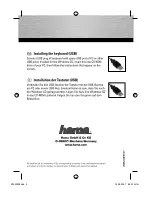
18
User Program Edit Parameters
Using Scale Tunings
Your E-A7 allows you to change the tuning of the keys, which then
applies to all notes of the same name.
Here’s an example:
if you press the Keyboard
[Bb]
button (indicator
lights), that note’s tuning is lowered by a quarter tone (–50 cents).
This setting applies to all B-flat keys on the keyboard.
Tuning individual notes a quarter tone down
1
Press the
[Scale Tune/Pad]
button to make it light.
Now you can use the Keyboard buttons as the Scale Tune buttons.
2
Press a Keyboard button to tune the corresponding
note a quarter tone down (the button must light).
3
If you also want to tune down other notes, press the
corresponding button(s).
If you pressed the wrong button (indicator lights), press it again so
that its indicator goes dark again.
The pitch of the corresponding notes returns to normal.
4
Long-press one of the Keyboard buttons.
The Scale Tune settings screen appears in the right display.
For each note, you can specify how much the tuning will be adjusted
when Scale Tune is enabled (button lit).
You can also access this page via
[Menu]
0
“User Program Edit”
0
“Scale Tune ”
5
Use the direct buttons and function buttons (page
buttons) to select the note whose value you want to
change, and use the Value
[-]
[+]
buttons to change the
value.
Setting Range :
-64– 63 cents
In this screen you can also switch the Scale Tune setting on/off for
each note.
Use one of the
[L1]
–
[L4]
buttons to select a note, and use the Value
[-]
[+]
buttons to switch the setting on/off.
MEMO
You can save the edited settings in a User Program.
&
“Saving Settings as a User Program”
(Owner’s Manual: p.
46)
Saving an edited scale tuning in Scale Memory
A scale tuning that you’ve edited can be saved in a user program or
in Scale Memory 1–3. To recall a scale tuning that you’ve saved, press
a Scale Memory button (to make the button light).
1
Tune the notes to your liking (see p. 17).
2
Press and hold the Scale Memory button (
[ I ]
–
[III]
) that
corresponds to the memory where you wish to save
your tuning settings.
3
Wait until all three MEMORY indicators briefly light,
then release the button you pressed.
If necessary, you can now select another, Scale memory by briefly
pressing the MEMORY button assigned to the settings you wish to
use.
To return to the tuning you were using before selecting a memory,
press the MEMORY button in question again so that its indicator goes
dark, and/or switch off all USER SCALE buttons whose indicators
light.
In the second case, the MEMORY indicator of the last memory
you selected starts flashing to signal that the current USER SCALE
settings no longer correspond to the ones of the last memory you
select. I.e. that memory is still selected, but has since been modified
(
“edited”
).
MEMO
If you press the
[Equal]
button (to make the button light), the
scale is set to equal temperament. If you press it again (to make
the button go dark), the scale returns to the previous state.
NOTE
See also
“Scale Tune Switch”
on p. 17 for deciding which
sections should be affected by the Scale Tune settings.
Pad Setting Parameters
Playing the Pads
When the
[Scale Tune/Pad]
button is unlit, the keyboard buttons
perform the Pad function.
You can use the Pad function to do the following two things.
Play Phrases
Phrases are sequence data for a single part such as guitar strumming
or a shaker.
Phrases are tempo-synchronized with the Style or SMF, and also
support chord detection.
* Phrases will not synchronize with WAV or MP3 songs.
















































